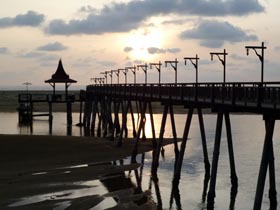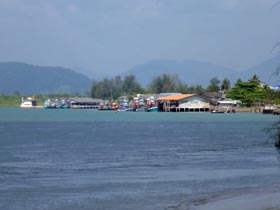Introduction to Phang Nga
 The holiday appeal of Phang Nga is very much enjoying the natural gifts nature has bestowed on this beautiful province. Phang Nga Province has all the natural attractions you could want for a varied and satisfying escape from the hustle and bustle of modern life. There are great stretches of glorious and unspoiled beaches. Inland is a vast amount of jungle covered mountains. The majority of the province’s land is totally undeveloped. There are several national parks and many beautiful waterfalls and caves. For the more energetic visitors, popular activities in Phang Nga include trekking, bird watching, rafting, kayaking, rock climbing and scuba diving. Or you can just relax on the beach.
The holiday appeal of Phang Nga is very much enjoying the natural gifts nature has bestowed on this beautiful province. Phang Nga Province has all the natural attractions you could want for a varied and satisfying escape from the hustle and bustle of modern life. There are great stretches of glorious and unspoiled beaches. Inland is a vast amount of jungle covered mountains. The majority of the province’s land is totally undeveloped. There are several national parks and many beautiful waterfalls and caves. For the more energetic visitors, popular activities in Phang Nga include trekking, bird watching, rafting, kayaking, rock climbing and scuba diving. Or you can just relax on the beach.
The west coast has great long stretches of glorious beaches. There are a few holiday resorts dotted all the way along this long stretch of coast but much of this shoreline is totally undeveloped and unspoiled. The main tourist area is Khao Lak which is on the central western coast. The area known as Khao Lak actually stretches out along several beaches just to the south of a town called Takua Pa. This is where the main density of holiday accommodation can be found with many beachfront hotels. It is also the area that has a good selection of restaurants, bars and shops.
Phang Nga has a quiet and fairly uneventful history. The capital town is first recorded in historical annals as Phunga City. The name later evolved into Phang Nga.
How to pronounce 'Phang Nga'? The 'Ph should be pronounced as a hard 'P'. The ‘a’ sound in Phang should be pronounced closer to the 'u' sound from 'run'. The second word 'Nga' has the tricky to pronounce Thai 'ng' sound at the start. Fortunately since the first part of the name ends in the 'ng' sound, it is quite easy to roll them together and pronounce something like 'pung-nga'.
During the conflicts in the 1700s between Thailand and Burma, nearby areas including Phuket were occupied by the Burmese but Phang Nga escaped the conflict and many people fled from Phuket to Phang Nga and expanded the town’s population. In 1933 the town was expanded to be a province.
While neighbouring Phuket boomed from the 1800s tin mining industry, Phang Nga had it's tin mining boom much earlier in the 15th century. This was the time that Takua Pa Town on Phang Nga's western coast became an international trading center. Eventually larger and better quality tin deposits were found in Phuket and Phang Nga province missed out or escaped, depending on your point of view, the massive financial boom that Phuket enjoyed. Instead Phang Nga’s economy relied on rubber plantations and other agricultural products and the province quietly moved on at its own pace.
Once international air travel became widely available to the masses in the 1970s, Phang Nga slowly started to take advantage of its natural attractions to become a tourist destination. However, it never went overboard and has always maintained itself as a quieter and more laid back destination than its noisy neighbour Phuket. There are no massed rows of sun loungers on the beaches. There are no jet-skis and banana boats skimming across the sea. There are no discos or go-go bars. There are no theme parks or great shopping malls.
Instead, Phang Nga developed a tourism industry based on its natural attractions of beautiful beaches and unspoiled jungle. Khao Lak became the main tourist area with a range of up-market hotels and smaller bungalow operations appearing along the beaches. The province’s most beautiful natural areas were declared national parks to protect them from development. The Similan Islands and the Surin Islands were turned into marine national parks and became protected world class scuba diving sites. Similarly Phang Nga Bay was made a national park to protect the glorious natural scenery of this area.
We can't talk about Phang Nga without mentioning the devastating tsunami on 26th December 2004. Phang Nga was the Thai province that suffered by far the worst impact from the tsunami. In particular, the flat plain of Khao Lak's beachfront area offered little resistance to the charging waters. The great waves swept over the beachfront resorts many of which were simple bungalow operations. The water kept coming all the way beyond the main road more than a kilometre inland. The destruction was devastating. While Phuket was hit hard by the tsunami, its naturally steeper terrain and lack of beachfront bungalows limited the damage. The tsunami killed approximately 600 people in Phuket. That is a tragic enough figure but by comparison, approximately 6,000 people were killed in Phang Nga.
 Khao Lak has always been a popular destination with Scandinavian visitors and sadly a huge number of Swedish people were among the victims. It is a tragedy that deeply affected Sweden where almost everybody knows somebody who lost their life in the tsunami. The Swedes are deeply scarred by what happened but they don't carry any bitterness with their pain. This is a tragedy they shared with the Thais. The Thai fishing village of Naam Kem (salt water) alone suffered a staggering loss of 700 lives.
Khao Lak has always been a popular destination with Scandinavian visitors and sadly a huge number of Swedish people were among the victims. It is a tragedy that deeply affected Sweden where almost everybody knows somebody who lost their life in the tsunami. The Swedes are deeply scarred by what happened but they don't carry any bitterness with their pain. This is a tragedy they shared with the Thais. The Thai fishing village of Naam Kem (salt water) alone suffered a staggering loss of 700 lives.
At the time, many people believed the tourism industry in Phang Nga would never recover but they have rebuilt. The beachfront resorts at Khao Lak have been restored, many of them a little stronger and a little higher. There are tsunami escape platforms, evacuation routes and early warning systems. In a way it is a shame that many of the smaller bungalow operations have been replaced by more developed resorts but some things had to change.
Phang Nga will never forget the tsunami but they have moved on. The tourism industry has fully recovered and the province offers a fantastic experience for visitors.

